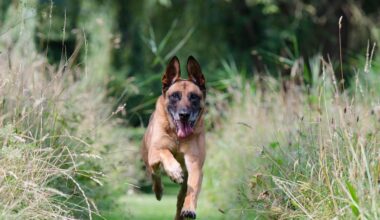Innovative Features in Modern Dog Training Obedience Boards
Dog training obedience boards have evolved substantially in recent years. Innovations in design and functionality have revolutionized the way we train our furry companions. Modern boards are equipped with features that make training more effective and enjoyable for both pets and owners. For instance, many boards now boast a textured surface that enhances grip, ensuring that dogs stay secure while they learn. Additionally, advanced materials are being utilized to enhance durability and longevity. Trainers can also enjoy customizable attachment points for various training tools. These enhancements promote flexibility, allowing for a broad range of training styles and methods. Furthermore, some boards now offer portability features, making outdoor training sessions more feasible. Owners can easily fold and transport these lightweight designs, encouraging training exercises in diverse environments. Safety features have also improved, reducing the risk of injury. Bark alerts and durable edges protect dogs during intensive training sessions. Consequently, modern obedience boards serve not just as training tools but as platforms for enhancing the bond between dogs and owners. Investing in quality equipment today will yield better results tomorrow, making training sessions rewarding for everyone involved.
Enhanced sensory experiences are a key attribute of modern dog training boards. Dog trainers increasingly recognize the importance of providing multisensory engagement during training. Boards now come with various textures and surfaces that appeal to a dog’s sense of touch. For example, some boards feature rubberized spikes or bumps, which encourage dogs to think critically about their steps. This approach promotes more mindful learning during obedience training sessions. In addition, the integration of sound components, such as clickers and electronic sounds, further engages a dog’s auditory senses. This combination helps reinforce positive behaviors more effectively. Furthermore, the visual elements of the boards play a crucial role. Brightly colored surfaces attract dogs’ attention, making the training process more fun. Visual reinforcement can include lights or patterns that reward good behaviors, enhancing learning through a system of positive reinforcement. This innovation captures a dog’s focus while associating specific actions with positive stimuli. Owners also find that these sensory components make learning a more interactive experience. Overall, incorporating sensory elements into obedience boards exemplifies the modern approach to dog training, making it an enjoyable adventure for both dogs and their humans.
Adjustable Features for Personalized Training
Another innovative feature gaining traction among dog training obedience boards is adjustability. Many contemporary boards provide options for height and angle adjustments, allowing trainers to customize the learning environment. Owners can raise or lower the board based on a dog’s size and comfort level. This personalized approach ensures that each dog can effectively engage with the training process. The ability to modify board settings according to training sessions’ specific goals makes a significant difference. For instance, adjustments can create challenges for more advanced learners while providing a safe and secure training surface for beginners. Trainers can also rotate boards to incorporate varying angles, enabling dogs to develop different muscle groups and strengthening coordination. This flexibility adds variety to routine practices while maintaining motivation during training. Additionally, markings or guides on adjustable boards can help trainers visualize progress over time. This is essential for assessing a dog’s development and tailoring future sessions accordingly. Furthermore, parents can rotate the boards to work on particular skills, fostering well-rounded obedience. Overall, adjustable features promise to maximize the effectiveness of training sessions for dogs of all skill levels.
Durability and maintenance have become significant considerations in modern dog training boards. Trainers are looking for products that stand the test of time and frequent use. The best boards are constructed from high-quality materials that resist wear and tear, ensuring long-lasting performance. Manufacturers now employ innovative materials such as high-density polyethylene or weather-resistant composites, which not only enhance durability but also reduce weight. These features make boards easier to handle while maintaining structural integrity during training sessions. Furthermore, easy-to-clean surfaces have gained popularity, allowing owners to maintain hygiene effortlessly. Regular training can lead to dirt and grime accumulation; therefore, designs that promote easy cleaning reduce maintenance time. Specifically, many boards are now made with non-porous surfaces that repel odors and stains. Some modern options even come equipped with UV protection to prevent fading and damage from sun exposure. Additionally, simple assembly and disassembly features save time during setup and transport. Choosing durable, low-maintenance boards is crucial for trainers seeking efficiency during training sessions. These attributes increase usability while providing peace of mind, knowing that the investment will last and remain functional through numerous training phases.
Incorporating Technology into Training
With technological advancements, many modern dog training obedience boards are now equipped with smart features. These tech-savvy boards can connect to smartphones or tablets, enabling trainers to track progress efficiently. Using specific training apps, owners can monitor their dog’s learning patterns and behaviors, providing crucial insights into each session’s effectiveness. Embedded sensors offer real-time feedback on a dog’s performance; trainers can receive alerts when targets are met. For instance, companies are integrating vibration technology to notify dogs of cues during training, enhancing the communication between dog and handler. This innovative approach enhances the training experience, making it interactive and engaging. Furthermore, some boards utilize gamification techniques, turning obedience training into a fun game. Owners often find this strategy encourages dogs to learn faster, as they associate training with play. This dynamic encourages consistent practice and reinforces positive behavior, ensuring better retention of learned commands. Trainers also benefit from data analytics, allowing them to adjust training methods based on a dog’s performance history. Incorporating technology into obedience boards revolutionizes traditional training methods, making them more appealing to a wider audience.
Safety remains a foremost concern for dog trainers, and modern obedience boards address this crucial aspect with thoughtful designs. Innovations prioritize user and pet safety during practice sessions. Many boards now incorporate anti-slip features, ensuring stability and preventing accidents while dogs practice commands. Edges are rounded and made from soft materials to reduce the risk of injury. Additionally, some boards include weight distribution technologies to balance heavier dogs safely. Another safety enhancement is the inclusion of quick-release mechanisms for training accessories, allowing trainers to remove tools swiftly during critical moments. Furthermore, visibility is another focus, with some designs featuring reflective materials for outdoor sessions during low-light conditions. This feature enhances safety by ensuring dogs remain visible, protecting everyone involved. Dogs learn best when comfortable and secure; therefore, the presence of safety elements promotes a more relaxed training atmosphere. Ultimately, a safe training experience contributes positively to a dog’s learning environment. Owners seeking effective obedience boards should focus on those that prioritize safety features, thereby ensuring productive training sessions without unnecessary risks.
Conclusion: Embracing Innovation in Dog Training
As identified, modern advancements in dog training equipment are shifting the paradigms of dog training experiences. Innovations such as improved materials, multi-sensory engagement, adjustable features, and technology integration represent significant improvements. These advances enrich the training experience for both dogs and their owners alike, facilitating deeper bonds and understanding. Trainers benefit from customizable boards that allow for personalized approaches, while dogs receive tailored experiences that foster enthusiasm and responsiveness. Additionally, attentiveness to durability and safety further enhances the practicality of these tools. It’s essential for owners to consider the innovative traits while selecting dog training obedience boards. By investing in well-designed equipment, trainers maximize training efficacy, yielding better outcomes while reducing potential frustrations. The modern approach to dog training not only enables obedience but also nurtures a dog’s innate curiosity and desire to learn. It encourages an enjoyable interaction throughout the training journey, celebrating progress and achieving milestones together. In sum, embracing innovation ensures that every training session becomes an opportunity for growth for trainers and their furry companions. Equip yourself with the right tools, and witness the potential unleashed during every training moment.
By exploring these innovative features, dog trainers today can transform training experiences into enjoyable adventures. Modern dog training obedience boards offer endless possibilities for effective training and reinforcement. The evolution of these tools reflects a commitment to enhancing canine education, ensuring that our beloved pets thrive in their learning journeys. With new techniques and equipment, responsible ownership blossoms through better communication and understanding.


